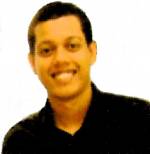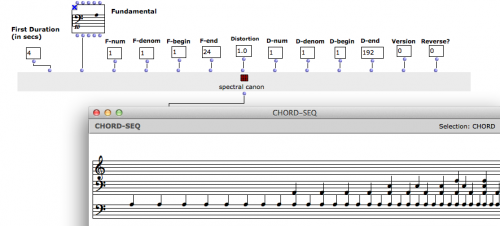Charles de Paiva Santana
PhD student in computational musicology.
Supervisors: Moreno Andreatta (IRCAM - CNRS), Jônatas Manzolli (UNICAMP - NICS), Jean Bresson (IRCAM - RepMus)
NICS
Rua da Reitoria, 165
Cidade Universitária "Zeferino Vaz"
13083-872 Campinas - BRAZIL
IRCAM
Equipe Représentations Musicales
1, place I. Stravinsky
75004 Paris - FRANCE
IRD
Programme Doctoral International Modélisation de Systèmes Complexes
32 Avenue Henri Varagnat
93140 Bondy - FRANCE
Charles.de.Paiva [at] ircam.fr
Research interests
- Computer-aided analysis and analysis by modeling
- Relationship between music and complex systems
- Algorithmic composition
In music history, models and modeling play different roles, demonstrating rich interactions between human knowledge and human activity. Examples as the Pythagorean and Chinese scales (mathematics), the construction of the organ and violin (acoustics) or the musical initiation through the àkonés in Central Africa and the Indian bandish (pedagogy and cognition) exist among many others. In western music composition, we identify them from the medieval canon and isorhythm to the utilization of mathematical models in Xenakis, Risset and the acoustic ones in 'spectral music'.
These fruitful relations between music and models denote the extreme complexity that embraces the most diverse musical activities. In the case of musical composition, according to the tripartite system proposed by Jean Molino, "it makes sense to speak, for a work or part of a work, of musical system and to focus on the complexity of that system" [Levy, 2004]. The computer science is well and long, interested in music, which is "an interesting field since very often the problems are of great complexity" [Agon, 1998]. Modeling, a recurring theme in computer music, aims to "formalize various aspects of musical phenomena and to construct the corresponding computer models, with the objective of understanding or analysis, at first, then often creating and producing music" [Bresson, 2007]. Furthermore, the use of models in music composition, whether from extra-musical or developed ad-hoc within its context, would be generalized more or less explicitly in most compositional activities [Malt, 2000].
We start from the idea that through modeling, certain musical pieces, often in their entirety, can become an "instance", usually the most "adequate" according to the wishes and goals of the composer, of a system which has attributes and methods. For example, if Grisey used in the first movement of his piece Vortex Temporum a "objet trouvé" borrowed from Ravel, this parameter could be changed for another musical material such as an ostinato by Stravinsky. The computer then re-evaluate the process, producing a new "instance" of the piece (not a reconstruction or arrangement), maintaining the integrity of the system.
By analyzing the different "instances" of a piece from the perspective of its implemented model, and evaluating thereby the potentialities of the compositional system, we move on a previously unexplored musicological terrain. We thus propose a musical analysis that takes into account not only the musical pieces in their "finished" appearance or the underlying theory used and developed by composers, but specially explores the pieces as part of an autonomous, independent and open system. Certainly, the modeling of musical pieces will lead us to considerations or even inevitable confrontations with the most complex aspects of a musical system and a creative process, as suggested by C. Agon: "This unique aspect of computer use [in the musical modeling] highlighted the non necessarily computable choices, without being irrational" [Agon, 1998].
Read a more complete description of my PhD project (french)
==
[Agon, 1998] Agon, C. (1998). OpenMusic : Un langage visuel pour la composition musicale assistée par ordinateur. Thèse de doctorat, Université Pierre et Marie Curie (Paris 6), Paris, France.
[Bresson, 2007] Bresson, J. (2007). La synthèse sonore en composition musicale assistée par ordinateur : Modélisation et écriture du son. Thèse de doctorat, Université Pierre et Marie Curie (Paris 6), Paris, France.
[Levy, 2004] Levy, F. Complexité grammatologique et complexité aperceptive en musique. Thèse de doctorat, Ecoles des Hautes Etudes en Sciences Sociales, Paris, France.
[Malt, 2000] Malt, M. (2000). Les mathématiques et la composition assistée par ordinateur (concepts, outils et modèles). Thèse de doctorat, Ecoles des Hautes Etudes en Sciences Sociales, Paris, France.
Exemples from the Spectral CANON for CONLON Nancarrow by James Tenney
all examples below are from MIDI files generated in OpenMusic
Extended version of the Spectral Canon (1974, 1990) 1)
With the same implementation inside OpenMusic we changed some parameters: a lower fundamental, faster durations, more voices, and moderate 'stretching' of pitches, voices entries and duration series. The computer then reevaluates the piece and returns an instance:
Here we used almost the same parameters as above except for choosing fewer voices, and strongly shortening the number of elements in the series of durations. Again, the computer just reevaluates everything and returns a simplified version of the piece, now played by a MIDI clarinet ensemble, micro-intervals are approximated to semitones.
Education
Since 2012:
- Co-supervised thesis between Université Pierre et Marie Curie (UPMC - Paris VI) and Universidade Estadual de Campinas (UNICAMP)
2010 - 2012:
- Master in Musicology. “Temporal processes in the work of Gérard Grisey”. Federal University of Paraíba (UFPB), Brazil. Direction: Prof. Didier Guigue. Supporter: Coordination for the improvement of Higher Education Personnel (CAPES).
2004 - 2009:
- Licenciate in Music. Federal University of Pernambuco (UFPE), Brazil.
2003 - 2004:
- Studies in Piano and Musical Theory. Conservatory of Pernambuco.
2001 - 2004:
- Studies in Piano, Musical Theory, Music History, Harmony and Counterpoint. Centre for Musical Creativity of Recife (CPCMR).
Publication and Posters
De Paiva Santana, Charles; Bresson, Jean; Andreatta, Moreno. Modeling and Simulation: The Spectral CANON for CONLON Nancarrow by James Tenney. (Sound and Music Computing Conference 2013 - Stockholm). smc2013.pdf
De Paiva Santana, Charles. La pièce musicale comme événement d'un système complexe, ouvert et modélisable: un cas de musicologie assistée par ordinateur. Journées Jeunes Chercheurs en Audition, Acoustique musicale et Signal audio 2013. Marseille, France.
Talks
- Analyse par modélisation informatique et création d'« instances » d'une pièce musicale. Seminaire MaMux. IRCAM, décembre 2012

